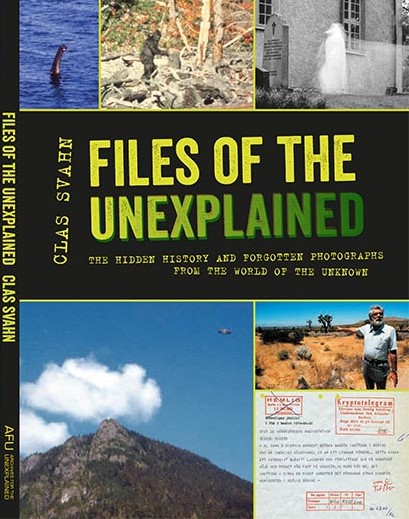
Reviewed by Nemo C. Mörck
Earlier this year an issue of the Paranormal Review dealt with archives of interest to students of psychical research. Mentioned in passing was the Archives For the Unexplained (AFU) in Norrköping, Sweden. AFU was founded in 1973 by Kjell Jonsson, Anders Liljegren and Håkan Blomqvist. The latter blogs about contactees and esotericism at ufoarchives.blogspot.com. AFU is probably the largest least known archive with extensive collections of literature about anomalous phenomena. Originally, its focus was on UFOs, but today the archive covers folklore, psychical research, sea monsters, spiritism and much more. Files of the Unexplained by Clas Svahn gives the reader some idea about what the archive includes.
Svahn is a journalist and works for one of Sweden's biggest newspapers, Dagens Nyheter. He maintains an active interest in ufology and is occasionally seen on TV and heard on radio in Sweden. Svahn has often been instrumental in securing donations to AFU. He is not a debunker nor a naive believer. After having investigated numerous cases Svahn is well-aware of normal causes for unusual observations, but some eyewitness accounts, photos and films makes one wonder about what was actually seen. That said, he notes that, concerning photos of UFOs: “In 99 percent of all cases, the objects can be explained satisfactory” (p. 58).
Fans of the The X-Files may remember an exchange between Dana Scully and Fox Mulder: “The Truth is out there, Mulder. But so are lies.” Svahn quotes from an email from Robert Rickard, the founder of Fortean Times, in which he remarks that the “myths and bluffs are as interesting as the real cases” (p. 10). Many skeptics will likely nod in agreement yet question if there are truly any real cases. One hoax is exposed and a film of Big Foot is also subject to some commentary.
Files of the Unexplained is a generously illustrated book of the kind that many contemporary students of psychical research read in their adolescence (when they were not watching The X-Files or Arthur Clarke commenting on anomalous phenomena). It contains a number of brief essays, focus being on UFOs. Although informative the essays spark curiosity rather than provide explanations. Fans of the books by Charles Fort, known for having collected “damned facts”, will naturally find this interesting. Nevertheless, to me, one of the more memorable accounts concern a visit to the late Gordon Creighton's home:
… scattered in stacks and piles were fifty years of documents, books and magazines from Creighton's time as editor for Flying Saucer Review. Everything was mixed with advertising, old newspapers and pure debris … we realized that the heap of books that we, at first, did not pay much attention to actually hid a staircase, which when we cleared it, led up to another floor which in itself proved to contain a library of several thousand volumes. In the garden, a shed was filled with boxes of more files ... (p. 20)
Another interesting account concern Henry Kjellson, considered a genius and not without reason: “At the age of fourteen he designed and built a camera and soon also a radio” (p. 27). Kjellson took his bachelor's degree when he was seventeen, and eventually became a civil engineer. He designed several aircraft for the Swedish Air Force.
In 1951, Kjellson published an article in a Swedish magazine, claiming that both Moses and Samson used explosives and hand grenades when they carried out their wonders, and that the sea animal which Job calls Leviathan in the Bible may in fact have been a steam-driven submarine equipped with a cannon tower. It caused quite a stir (p. 27).
Files of the Unexplained does however contain little about psychical research, arguably far too little given the extensive collections at AFU. Conan Doyle and the medium George Valiantine makes a brief appearance. The account about spirit photography would have benefited from some elaboration. Skeptics will be annoyed because the trickery often utilized by spirit photographers is not exposed. Throughout the book, in the margin, one finds Suggested Reading, I must admit that I disagree with some of the choices, but newcomers may find this useful. That said, this book is primary meant to make readers aware of some of the contents in the collections housed at AFU and it is bound to spark curiosity.

